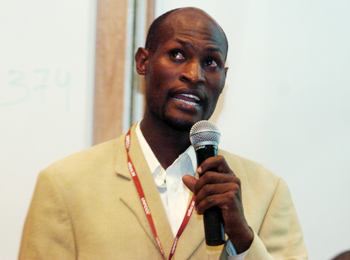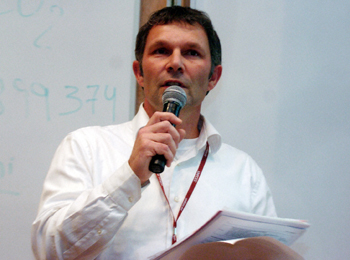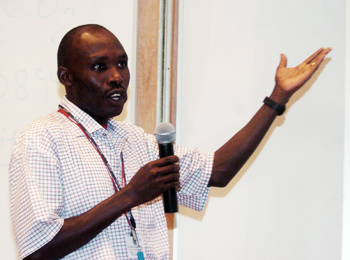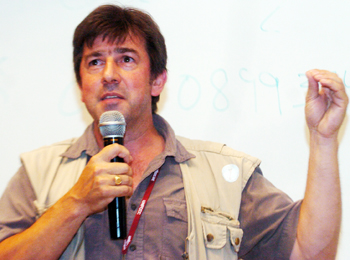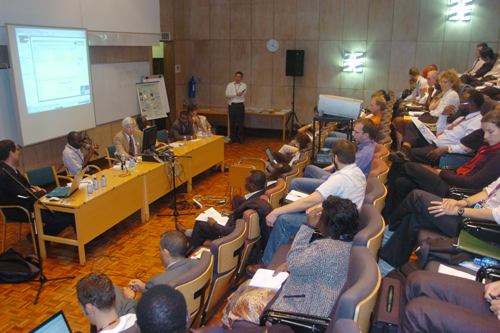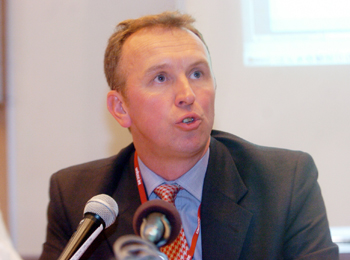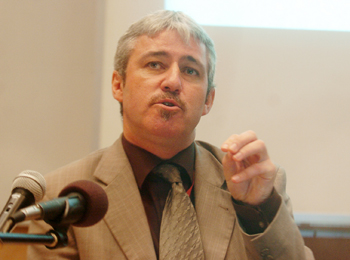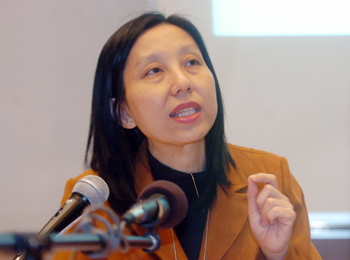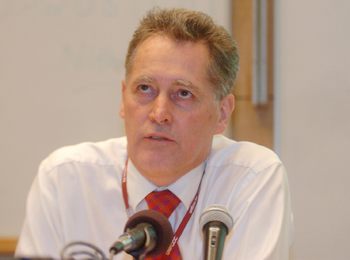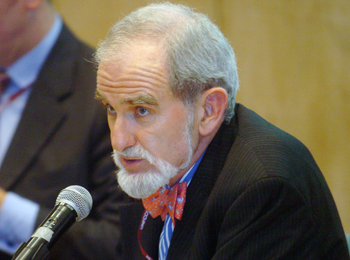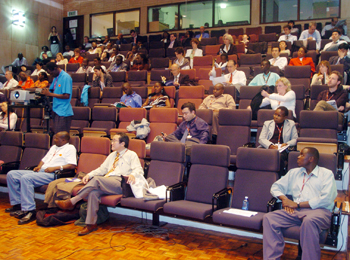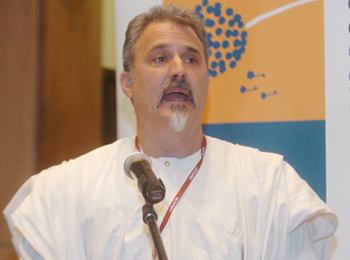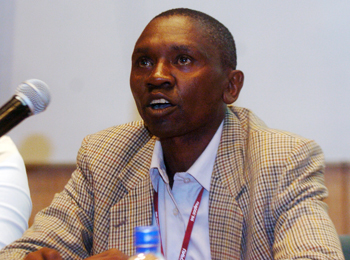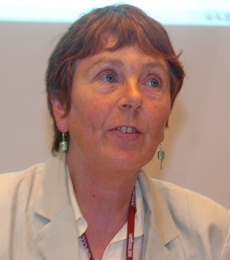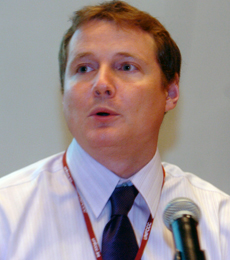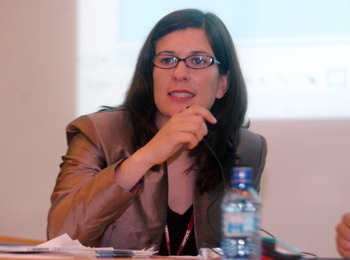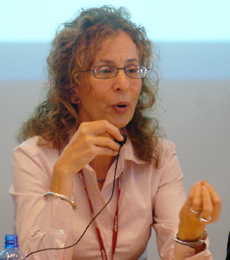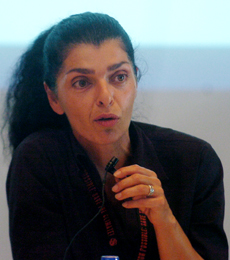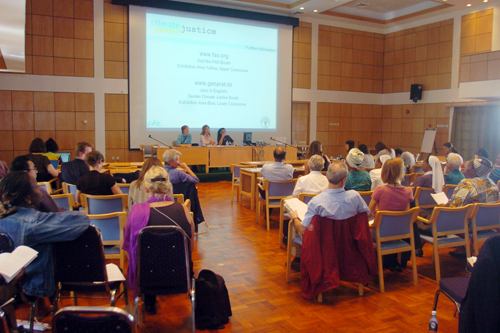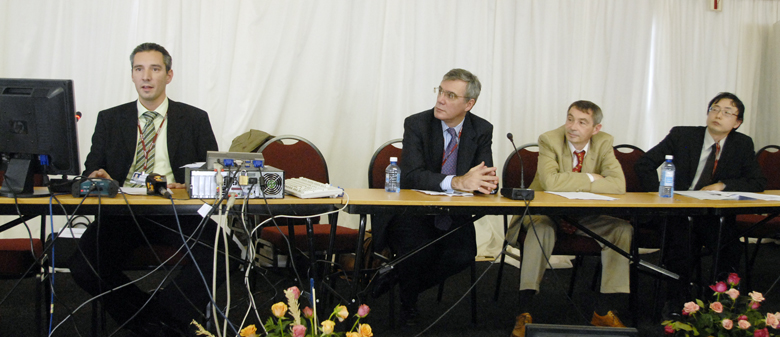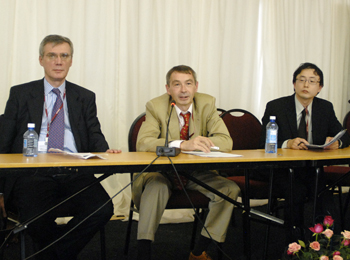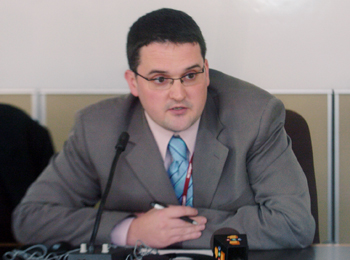 |
||
|
Published by the International Institute for Sustainable Development (IISD)
|
|||
|
A Special Report on Selected Side Events at the Second Conference of the Parties serving as the Meeting of Parties to the Kyoto Protocol (COP/MOP 2) and Twelfth Conference of the Parties (COP 12) to the UN Framework Convention on Climate Change (UNFCCC)
|
|||||
| 6-17 November 2006 | Nairobi, Kenya | |||||
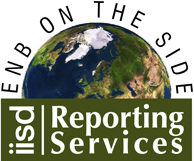 |
|||
 |
|||
Events convened on Thursday, 9 November 2006
|
Community-based AR and biomass projects – report from a developers’ workshop organized by ENCOFOR Presented by Joanneum Research |
|||
|
Igino Emmer, Face Foundation, outlined the outcomes of the Environment and Community Based Framework for Designing Afforestation, Reforestation and Revegetation Projects (ENCOFOR) Workshop held on 5 November 2006 for project developers in East Africa.
Frederik Njau, Green Belt Movement (GBM), Kenya, described a small-scale reforestation CDM project that GBM is undertaking to rehabilitate degraded land in the Aberdare Range by planting indigenous species. Albert Ackhurst, Baartman-Biko Environmental Research Initiative, explained how this local afforesestation/reforestation (AR) project seeks to re-establish natural biodiversity in forests in an “accelerated” manner in South Africa, citing “insensitivity to Africa” as a barrier to project success. Simon Amunau, Straight Talk Foundation, highlighted a pilot afforestation scheme in North and Northeastern Uganda, describing how trees are planted on abundant primary and secondary school land, where the potential to promote environmental education is high. Neil Bird, Joanneum Research, presented a proposal to increase the limit for AR projects from 8,000 to 30,000 tons of carbon dioxide equivalent per year in order to overcome the financial barrier faced by such projects. Bernhard Schlamadinger, Joanneum Research, presented on new methodologies to reduce the use of non-renewable biomass, and said he hoped the COP/MOP will request the CDM Executive Board to approve methodologies for replacement or reduction of non-renewable biomass. Anthony Maina, Ministry of Environment and Natural Resources, Kenya, highlighted three land tenure arrangements the Forest Department uses to engage communities in community-based AR CDM projects, namely joint management agreements, licenses and concessions. Girma Amente, Bureau of Agriculture and Rural Development, Ethiopia, noted that tension exists between achieving sustainable development goals and creating a high volume of CERs in AR CDM projects. Peter Minang, International Institute for Geo-Information Science and Earth Observation (ITC), described ITC’s work on developing data infrastructures and using technologies to acquire data required for AR CDM projects. Timm Tennigkeit, Unique Forestry Consultants, summarized by saying that carbon alone does not make a project viable, but rather has the potential to leverage a whole sustainable development process. |
|||
|
|||
|
Broadening the base of financing for technology transfer: a progress report on the Private Financing Advisory Network Presented by CTI |
|||
|
Elmer Holt, Chair of the Climate Technology Initiative (CTI), introduced CTI’s activities and the consulting services of Private Financing Advisory Network (PFAN) on developing project proposals for technology transfer.
Terry Carrington, CTI, presented a brief history and tools available at CTI to help enhance access to financing for technology transfer projects. Wanna Tanunchaiwatana, UNFCCC, overviewed the current status of UNFCCC’s work on technology transfer, highlighting UNFCCC’s activities on technology needs assessments (TNA). She underscored the need for further work on integrating TNAs with the second National Communications of Non-Annex I Parties. She also elaborated on the UNFCCC’s activities in issue areas such as enabling environments and innovative financing. Bernard Mazijn, Chair of the Expert Group on Technology Transfer (EGTT), outlined EGTT’s work on innovative financing for technology transfer. He drew attention to the discussion at the Bonn 2006 and Montreal 2005 climate workshops that led to the development of the practitioners guidebook for preparing technology transfer projects called “ A guidebook on preparing technology transfer projects for financing,” and discussed its contents and some outreach activities. Peter Storey, Hera International, described his company’s activities and presented on the services offered by the Private Financing Advisory Network (PFAN), which include advice on project financing structure and sourcing and procurement of financing. He highlighted key project selection factors and discussed sample projects, including a biodiesel project in Brazil and a small-hydro project in Chile. Participants questioned the time duration involved in the application process and sought clarification on acceptable project types. |
|||
|
|||
|
Community-based adaptation - how and why it works, and ways to mainstream Presented by Practical Action |
|||||
|
Jeff Woodke, Jemed Youth with a Mission, Niger, explained that droughts interspersed with abnormal rainfall patterns affect nomadic economies and outlined an example of climate change adaptation by nomadic communities in Niger. He explained the notion of “fixation points” as places where communities can access basic social services and enable regeneration and management of rangelands. Florence Mativo, Mtito Andei Development Initiative, Kenya, shared the experience of Kathekani, a semi-arid area facing "drastic" climate change, including prolonged droughts, and noted that this exacerbates poverty in the area. Peter Mangala, Mtito Andei Development Initiative, Kenya, highlighted climate change adaptation strategies, including: livestock production of goats, training community members on animal health practices; and establishing seed banks, which allow communities to access drought-tolerant crops. K.M. Mizanur Rahman, Practical Action, Bangladesh, described a project in Gaibandha district, a densely-populated area vulnerable to floods and erosion, that seeks to raise community awareness of the causes of climate change offer training and strengthen community livelihoods. Rahman stated that impacts include: increased community awareness of the source of GHG emissions and enhanced skills to survive disaster conditions. Rachel Berger, Practical Action, UK, stated that her organization seeks to up-scale good practices, and highlighted the organization’s capacity-building interventions. She suggested that national government action should incorporate planned expenditure for climate adaptation. She emphasized using a “programme-” over a “project-” based approach that incorporates community concerns. Tom Mitchell, Institute for Development Studies (IDS), UK, launched the report “Overcoming the barriers: Mainstreaming climate change adaptation in developing countries.” |
|||||
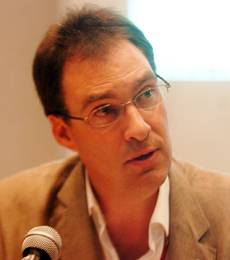 |
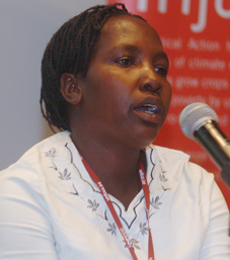 |
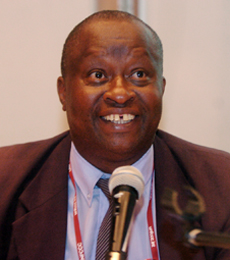 |
|||||
|
Andy Atkins, Tearfund
|
Florence Mativo, Mtito Andei Development Initiative, Kenya
|
Daniel Theuri, Practical Action
|
|||||
|
|||
|
Clean energy development in Asia and the Pacific Presented by ADB |
|||||
|
Amy Kean, Renewable Energy and Energy Efficiency Partnerships (REEEP) Secretariat, outlined key finance issues relating to renewable energy in the Asian region, including: the importance of local finance; the need to draw in conventional financial institutions; the immaturity of the equity market; and the limitation of special funds. Summarizing the major barriers for financing renewables, she noted the establishment of the Renewable Energy Exchange (REEX) to bridge the gap between project developers without financial sources and financiers without bankable projects.
Praser Sinsukprasert, Department of Alternative Energy Development and Efficiency, outlined Thailand’s Energy Efficiency Revolving Fund (EERF), which aims to stimulate and leverage commercial investment for energy efficiency improvements and familiarize commercial banks with the energy efficiency lending market. Sinsukprasert summarized EERF approaches to overcome financial barriers, including: providing initial capital to the market for energy efficiency without any cost; establishing a lower interest rate for such projects relative to business-as-usual market rates; minimizing governmental interventions; and simplifying procedures to access loans. Samuel Tumiwa, Asian Development Bank (ADB), outlined two innovation finance mechanisms used by ADB, which aims to help its members in the Asia and Pacific region in reducing poverty. He noted that energy security is the biggest driver for the region to promote clean energy programmes. He outlined ADB’s several initiatives to finance environmental programmes, notably the Energy Efficiency Initiative that focus on the supply- and demand-side of the energy market, and the Asia Pacific Fund for Energy Efficiency that is used for technology deployment and technical assistance. Participants discussed the financial barriers of promoting renewable energy projects in developing countries and the mechanism of donors backing-up loans such that local communities can access financial funds for implementing renewable energy projects. |
|||||
|
|
|||
|
Research on gender aspects of climate change: preliminary findings Presented by LIFE-Women Develop Eco-techniques |
|||
|
Yianna Lambrou, UN Food Agriculture and Organization (FAO), introduced preliminary results of the literature review on gender aspects of climate change and invited participants to provide feedback and inputs.
Ulrike Röhr, LIFE, stated the project is a response to the lack of data on gender and climate change and aims to assess relevant research and identify knowledge gaps. She said it seeks to examine emissions and energy consumption patterns disaggregated by gender, explore mechanisms to incorporate women and men’s perspectives in policy measures and develop a draft analytical framework on gender and climate change. Hemmati explained that the dimensions of analysis are psychosocial, socioeconomic, legal, political, physical, biological and global. She lamented the tendency for “one size fits all” early warning systems, suggesting that given differential access to information by men and women, women suffered serious consequences during disasters. Hemmati stated that gender role and gender identity perspectives would show that disaster coping patterns are gender specific. She noted that the disaster recovery phase could allow new gender roles to emerge. Hemmati summarized the next steps as: continuing the research review, completing the analytical framework by April 2007 and publishing recommendations that support gender mainstreaming in ongoing negotiations in summer 2007. A participant cautioned against “woman bias” and suggested a balance between ensuring that women are kept at the forefront and taking on board the perspectives of men. |
|||
|
|||
|
Carbon market infrastructure: implementing the international transaction log Presented by UNFCCC |
|||
|
Vitaly Matsarski, UNFCCC, said the International Transaction Log (ITL) is a communication hub to connect all registries, check transactions against registry system standards and allow registries to initialize their connection by April 2007. He noted that the EU ETS was designed to fit under the Kyoto trading “umbrella,” allowing trading of CDM credits and joint implementation.
Ronald Velghe, Trasys, explained that his company is responsible for designing and implementing the ITL software, hardware and software support, deployment and operation, testing and acceptance of the system. He noted that after the system is established, another company called LogicaCMG will deal with the operation and service desk. Noting the challenge of dealing with 37 registries across 13 time zones, Velghe highlighted the next steps of Trasys’ work, including implementing: reconciliation support among registries; UNFCCC data system integration; and registry initialization support. On behalf of LogicaCMG, Velghe highlighted that LogicaCMG will be in charge of providing a live ITL environment and service desk, delivering support to remote registries, and carrying out initialization, networking, monitoring and reconciliation. Toshiaki Nagata, UNFCCC, detailed how CER transactions will take place and provided an overview of transaction and registry communication through screenshots taken from registry systems. He presented hypothetical transactions on issuance of CERs into the CDM registry, forwarding CERs to national registries and retirement of CERs within national registries. Andrei Marcu, President of the International Emissions Trading Association (IETA), underscored the importance of ITL becoming operational by January 2008 to avoid reducing market confidence, diminish liquidity and lower prices for emission reductions. |
|||
|
|||
|
Technology as a solution to climate change Presented by ICC |
|||
|
Nick Campbell, International Chamber of Commerce (ICC), highlighted the progress of technology transfer through CDM, and stressed the need for the right enabling environment for technology transfer to move ahead.
Vincent Mazauri, Schneider Electric, discussed a methodology for promoting energy efficiency in the French electricity sector. Describing the methodology, he showcased the energy drain that occurs when primary energy such as natural gas is converted to electricity. He noted the role of the MARKAL approach for long-term planning and modeling of the electricity sector. Luke Warren, IPIECA, discussed the role of carbon capture and storage (CCS) and geological storage to mitigate climate change. He highlighted that industry is confident that CCS can be practiced safely and is prepared to work with others. He underscored the importance of an effective legal and regulatory framework for deployment of CCS. Masayuki Sasanouchi, Toyota Motor Corporation, presented Toyota’s perspective on climate change policies. He noted a number of relevant industry approaches for climate change mitigation including life cycle analysis, eco-efficiency, and the “front runner” approach. Brian Flannery, Exxon Mobil, presented business perspectives on frameworks for technology development and deployment to address climate risks. He noted some business approaches to addressing uncertainties, suggesting that regulatory certainty can never be guaranteed. He then highlighted a number of criteria for technology evaluation, noting that failure in any of these dimensions would stop widespread commercialization. Participants discussed replicability of the energy efficiency systems used in the French electricity sector and the viability of CCS projects vis-à-vis CDM and EU-ETS. |
|||
|
|||
|
||
|
Click the above button to go back to our ENB main coverage
|
||
|
|
|
|
|
||
|
